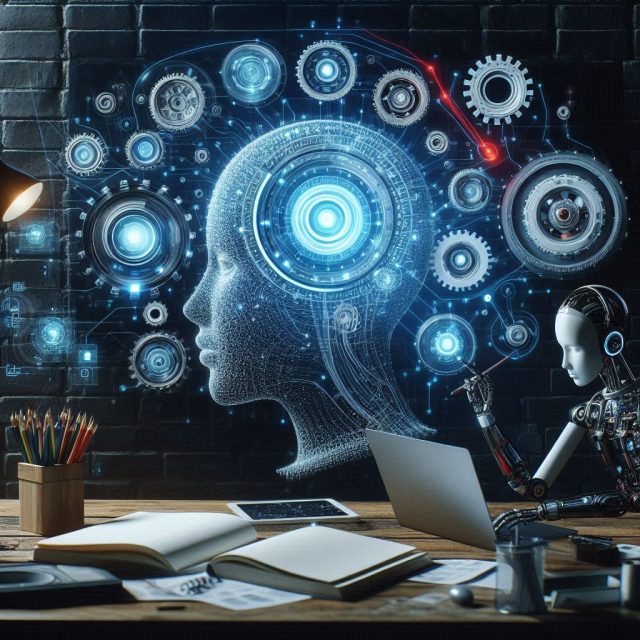In recent years, the intersection of artificial intelligence (AI) and creative writing has become a fascinating area of exploration and innovation. From generating text to aiding writers in their craft, AI’s influence on creative writing and content generation is profound and multifaceted. This influence extends across various domains, including literature, journalism, marketing, and even personal writing projects. This essay delves into the ways AI is transforming creative writing and content generation, examining both its potential benefits and the challenges it presents.
1. Understanding AI in the Context of Creative Writing
AI in creative writing primarily involves the use of algorithms and machine learning models to generate, assist with, or enhance written content. These technologies are built on extensive datasets and sophisticated natural language processing (NLP) techniques, allowing them to understand, generate, and manipulate text in increasingly sophisticated ways.
1.1. AI Models and Techniques
The core technology behind AI in creative writing is the development of models like OpenAI’s GPT (Generative Pre-trained Transformer) series, Google’s BERT (Bidirectional Encoder Representations from Transformers), and other advanced NLP systems. These models are trained on vast amounts of text data from diverse sources, enabling them to generate coherent and contextually relevant text based on user inputs.
GPT-3, for example, is known for its impressive ability to produce human-like text, making it a valuable tool for various writing tasks. It can generate articles, stories, poetry, and even assist in brainstorming and idea generation.
1.2. The Role of Machine Learning
Machine learning algorithms enable AI to learn from vast amounts of textual data and improve their performance over time. By analyzing patterns in language, grammar, style, and context, these algorithms can produce content that mimics human writing styles. They can also adapt to different genres, tones, and formats, making them versatile tools for writers.
Empowering Tomorrow with Cutting-Edge Technology Today.
2. Applications of AI in Creative Writing
AI’s impact on creative writing and content generation is evident in several key areas, each showcasing the technology’s potential and versatility.
2.1. Content Generation
One of the most prominent applications of AI is in content generation. AI tools can produce articles, blog posts, and social media updates quickly and efficiently. This capability is particularly valuable for businesses and content creators who need to produce large volumes of content on a regular basis.
For example, AI-powered platforms like Jasper and Copy.ai offer services that generate marketing copy, product descriptions, and even entire blog posts. These tools can save time and reduce the workload for content creators, allowing them to focus on higher-level tasks such as strategy and creative direction.
2.2. Creative Writing Assistance
AI can also assist writers in their creative process by providing suggestions, enhancing their writing, and offering new perspectives. Tools like Grammarly and Hemingway Editor use AI to offer grammatical corrections, style improvements, and readability suggestions. This type of assistance helps writers refine their work and produce polished, professional content.
Moreover, AI can act as a collaborative partner in the writing process. Writers can use AI to brainstorm ideas, generate plot outlines, or develop character dialogues. For instance, AI can provide multiple plot twists or character traits based on initial input, helping writers overcome creative blocks and explore new directions.
2.3. Personalized Content
Personalization is another area where AI has a significant impact. AI algorithms can analyze user data and preferences to create tailored content that resonates with specific audiences. This approach is particularly useful in marketing and advertising, where personalized content can enhance engagement and conversion rates.
AI-driven recommendation systems, such as those used by content platforms like Netflix and Spotify, provide users with personalized content suggestions based on their previous interactions. This level of personalization extends to written content, where AI can generate articles or stories that align with a reader’s interests and preferences.
2.4. Interactive Storytelling
Interactive storytelling is an emerging field where AI is playing a crucial role. AI-driven interactive narratives and chatbots can create dynamic, user-driven experiences that adapt to individual choices and inputs. This technology is used in video games, educational tools, and immersive storytelling platforms.
For example, AI can power interactive fiction where readers make choices that influence the story’s direction. This level of interactivity enhances engagement and provides a unique experience for each user. Similarly, chatbots and virtual assistants can engage users in conversations that mimic human interactions, creating personalized and immersive experiences.
3. Benefits of AI in Creative Writing
The integration of AI in creative writing and content generation offers several benefits, including efficiency, creativity, and accessibility.
3.1. Increased Efficiency
AI can significantly speed up the writing process by automating routine tasks and generating content quickly. This efficiency is especially valuable for businesses and content creators who need to produce a high volume of material within tight deadlines. By automating content generation, AI frees up time for writers to focus on strategic and creative aspects of their work.
3.2. Enhanced Creativity
AI can act as a creative partner, offering new ideas and perspectives that writers might not have considered. By generating multiple options for plotlines, character development, or stylistic choices, AI helps writers explore different creative avenues and enhance their storytelling capabilities.
3.3. Improved Accessibility
AI tools make creative writing and content generation more accessible to individuals who may not have advanced writing skills or professional training. By providing grammar and style suggestions, as well as generating content ideas, AI helps users produce high-quality material regardless of their expertise level.
4. Challenges and Limitations of AI in Creative Writing
Despite its advantages, AI’s influence on creative writing and content generation also presents several challenges and limitations.
4.1. Quality and Authenticity
While AI can generate coherent and contextually relevant text, the quality and authenticity of the content can vary. AI-generated text may lack the depth, nuance, and emotional resonance of human writing. Additionally, AI tools may produce content that is repetitive or formulaic, affecting its overall quality and originality.
4.2. Ethical Concerns
The use of AI in creative writing raises ethical concerns related to authorship and intellectual property. Questions about who owns AI-generated content and how it should be credited are important considerations. There is also the issue of potential misuse, such as generating misleading or harmful content.
4.3. Creative Limitations
AI tools, while advanced, still have limitations in their ability to understand context and generate truly original content. They rely on existing data and patterns, which means they may struggle with tasks that require deep creativity, emotional insight, or complex narrative structures.
4.4. Dependency on Technology
The growing reliance on AI tools for writing and content generation may lead to a dependency on technology. Writers and content creators might become overly reliant on AI, potentially diminishing their own creative skills and critical thinking abilities.
Wellness Redefined: Your Health, Our Priority.
5. The Future of AI in Creative Writing
Looking ahead, the influence of AI on creative writing and content generation is likely to evolve further. Advances in AI technology, including improved language models and more sophisticated algorithms, will continue to enhance the capabilities of AI tools.
5.1. Integration with Human Creativity
The future of AI in creative writing may involve greater integration with human creativity. Rather than replacing human writers, AI could serve as a collaborative tool that augments their abilities and provides new creative possibilities. This partnership could lead to innovative forms of storytelling and content creation.
5.2. Ethical and Regulatory Developments
As AI becomes more embedded in creative writing, ethical and regulatory considerations will become increasingly important. Establishing guidelines for the use of AI in content creation, addressing issues of authorship and ownership, and ensuring transparency in AI-generated content will be crucial for maintaining integrity and trust.
5.3. Evolving Applications
The applications of AI in creative writing will likely expand to new areas and industries. From interactive entertainment to personalized education, AI’s role in content generation will continue to grow, offering new opportunities and challenges for writers and creators.
Conclusion
The influence of AI on creative writing and content generation is profound and multifaceted. AI technologies have the potential to enhance efficiency, creativity, and accessibility in writing, offering valuable tools and support for writers and content creators. However, the integration of AI also presents challenges related to quality, ethics, and creative limitations.
As AI continues to evolve, its impact on creative writing will likely grow, shaping the future of storytelling and content creation. By embracing the opportunities and addressing the challenges, writers and creators can leverage AI to explore new creative possibilities and redefine the boundaries of their craft.





